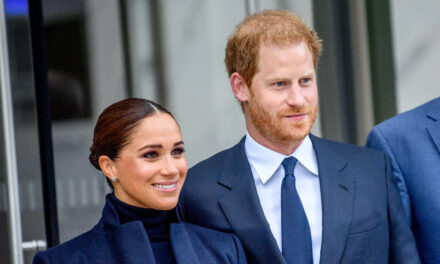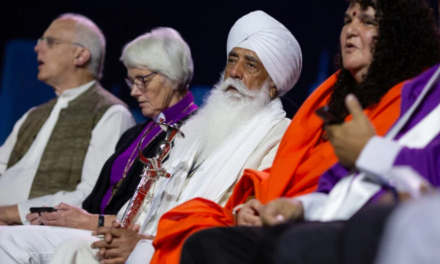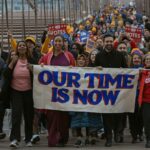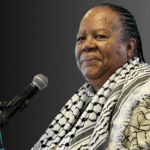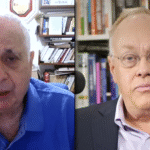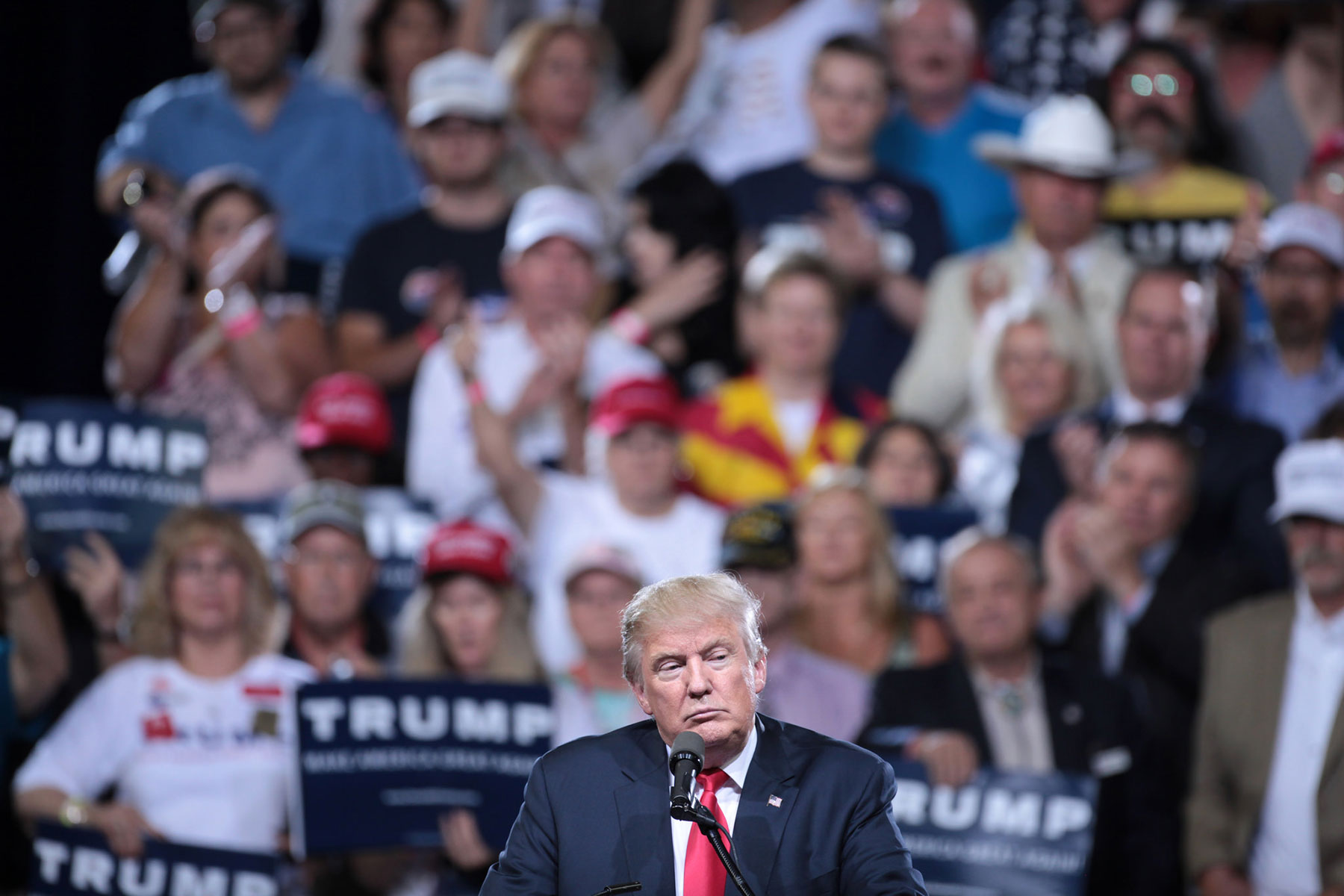
A new study by researchers at the University of Warwick investigates the relationship between Donald Trump’s tweets and anti-Muslim hate crime—with sobering results for social media optimists.
Social media has recently come under increasing scrutiny for, it is said, reinforcing people’s existing viewpoints in “echo chambers.” Whether it is jihadist terrorism, the Rohingya genocide in Myanmar, or Brexit, Twitter and Facebook are on trial—prompting even the usually reserved Mark Zuckerberg to apologize in person for his company’s missteps in the US Congress and European Parliament. But despite the public outcry, there is surprisingly little hard evidence about the link between social media and real-life outcomes.
In recent research, we look at the role of Twitter’s arguably most prominent user: President Donald Trump. Many commentators have criticized Trump for his inflammatory rhetoric on Twitter, and even cited him as an example of how social media can incite hateful sentiment against minorities. Whether his sharing of anti-Muslim videos or infamous call for a border wall with Mexico, Trump has certainly used Twitter to spread some of his most controversial messages. But are his words also associated with actions outside the online world?
In the paper “Making America Hate Again? Twitter and Hate Crime under Trump,” we investigate the correlation between Trump’s tweets, differences in local Twitter usage, and hate crimes in the US. To start, we document that the overall number of hate crimes since Donald Trump’s presidential election have slightly increased compared to Obama, but are comparable to previous presidencies. At the same time, the months since Trump’s election have been a striking outlier for anti-Muslim hate crime, which has increased substantially.
We also find a tight link between the content of Trump’s Twitter messages in a given week and subsequent real-life events. In particular, the timing of Donald Trump’s tweets about Muslims coincides closely with anti-Muslim hate crimes. Indeed, the Muslim tweets have substantial forecasting power up to three weeks into the future, even after controlling for the general attention paid to Islam-related topics. This is particularly true for hate crimes carried out in areas where many people use Twitter, which we define as counties above the 90th percentile of Twitter users per capita.
At the same time, Trump’s tweets about Muslims are uncorrelated with hate crimes before the start of his presidential campaign. They are also uncorrelated with hate crimes against other minorities—religious, ethnic, racial, or otherwise. This suggests we are not merely picking up weeks of heightened anti-minority sentiment. Although somewhat weaker, we also find evidence that Trump’s tweets about Hispanics are associated with anti-Ethnic hate crimes—but again, only after his campaign kick-off.
The geographical data on Twitter usage across counties reveals another striking pattern. We find that the marked uptick in anti-Muslim hate crimes began with the start of Donald Trump’s presidential campaign in June 2015, and was almost exclusively driven by counties with many Twitter users. The three months with the highest number of anti-Muslim hate crimes since Trump’s presidential run coincided with three important events in Trump’s campaign: (1) his demand for a Muslim travel ban, (2) his endorsement of torturing potential terror suspects in the wake of the Brussel Terror Attacks, and (3) the month of his presidential election. All of these spikes in hate crime occurred in areas with high Twitter usage.
The relationship between Twitter and the shift in anti-Muslim hate crimes since Trump’s presidential run also remains remarkably stable if we take into account differences in voting patterns, ethnic composition, economic conditions, or crime across counties. Indeed, counties with higher Twitter usage were less likely to vote Republican in the last three presidential elections, and in particular for Trump. These counties also show lower levels of poverty among children and the elderly, and a higher share of minorities. We also find no comparable relationship between Twitter usage and other hate crimes since Donald Trump’s presidential run.
A potential concern with these findings might be that counties in which many people use Twitter today may be inherently different in ways that we cannot easily control for. For example, there may be differences in racial bias, persistent attitudes towards particular social groups, or historical experiences that might flare up spontaneously when triggered by political events such as Trump’s candidacy.
So how likely is it that such unobservable factors can explain the disproportionate increase of anti-Muslim hate crimes in counties where many people use Twitter today? We tackle this question by comparing the location of hate crimes under Trump to all previous presidencies since 1990. We find that Trump is a striking outlier: in comparison to all other presidents, hate crimes targeting Muslims have only become concentrated in areas with high Twitter usage under Trump.
In fact, by our preferred measure, anti-Muslim hate crimes were less likely to occur in areas where many people use Twitter today during the Clinton and George W. Bush presidencies. While far from conclusive, these findings make it unlikely that we are merely capturing long-standing factors that have caused the recent flaring up of religious-motivated crimes.
Overall, our findings point towards a potential link between Twitter and hate crime. Of course, we do not claim that Donald Trump’s presidential campaign, or social media itself, is the immediate cause of the increase in anti-Muslim hate crime. Rather, we document that Trump’s presidential campaign marks a caesura for the connection between Twitter usage and hate crimes in the United States. But some related research might make even the most ardent social media optimist rethink.
In a paper on right-wing Facebook users in Germany, we use Internet disruptions and Facebook outages to get closer at a causal effect of social media. What we find is that the correlation between social media posts and violent attacks on refugees vanishes when users are cut off from Facebook. In other research, Ruben Enikolopov, Alexey Makarin, and Maria Petrova have shown that Russia’s dominant social network VK—which gained popularity through its founder’s university classmates—has played a role in the country’s 2011 protest wave.
Our findings are consistent with the idea that Trump’s presidential campaign aided an unraveling of social norms that made people more willing to express views that were previously deemed socially unacceptable—an unraveling that may have prompted a few people to carry out hate crimes. Taken at face value, this means that we need to understand social media if we want to understand how hateful sentiments spread in the 21st century.
Karsten Müller and Carlo Schwarz
Gage Skidmore
Originally published by on Pro Market as Is Social Media Associated with Real-World Violence? A Study of the US President’s Tweets


